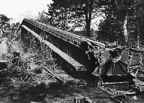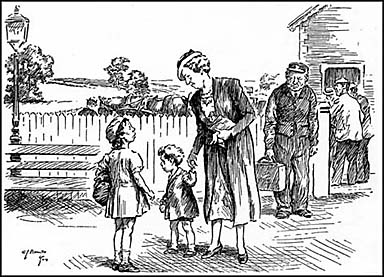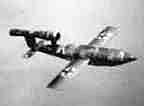Terror
from the sky
Buzzbombs
By
Wallace Wood ...............................................................................................Click
images for a larger view
Terror
from the sky
Buzzbombs
By Wallace Wood ...............................................................................................Click images for a larger view
September 11, 2001, just two airliners brought down two of the greatest buildings in the world-The Twin Towers of New York.
| What if New Yorkers faced not two
"flying bombs" that day, but two hundred? That was the way it was in England's capital city of London. Not recently, when terror bombers blew up small backpacks in the subways and buses of the city and killed dozens of Londoners. No, it was 61 years ago, in 1944 when thousands died, as they did in New York. We can safely look back now at that time knowing it's long gone. Or does the date 9/11 remind us otherwise? |
|
|
Imagine “Ground Zero”
in New York multiplied dozens of times all over the city day after
day.
|
"The V-1s were quite noisy
and you could hear them in the air-raid shelter. They sounded like
a motorbike running without a silencer. You would listen for them
to stop and if they stopped overhead you knew they would hit close
by." That's what Jim Woods remembers. "Buzz bombs". "Doodlebugs". They sounded like a loud two-stroke motorcycle, people who heard them will tell you. But the scary part was the silence. That meant the V-1's pop-popping jet engine had quit. The bomb was on its way down. |
A tiny little propeller like a toy airplane's stuck
out the front. It didn't push anything. It just spun a long screw. When
the screw turned over so many times, a switch turned the engine off and
the V-1 became a "Diver" headed for the ground and self-destruction
like a mindless suicide bomber. German engineers figured out just how
many turns it took to go just so far.
The fat thing on top like a stovepipe was the simplest of jet engines.
Toss the V-1 in the air fast enough and the wind would push open the air
intake and cheap gas or kerosene would be squirted in and sparked off.
That was the first "sputt".
|
Hitler had high hopes for the
V-1. He wasn't crazy. Cheap to make, he ordered them in the thousands,
and 9,500 were launched at Britain. Another 6,500 were launched
at other targets. More than 14,000 people were killed and 35,000
injured. One bomb could take out a big building. In fact, it took
out many buildings at once, leaving much of London in rubble. A
million people left London to get away from the bombs, most of them
children sent to visit relatives by their frightened parents.
|
 V1 Launching ramp. Picture thanks to Fiddlers Green |
Read Alan Pearson's story of how the British fought these terror weapons.
Most people have heard of the Spitfire, and maybe even the Hurricane, two great airplanes that helped turn the Germans back from invading Britain. That was "The Battle of Britain" before the first "Blitz" and is a story in itself.
Few have heard of the Mosquito, the "Tiffy" Typhoon, the Gloster Meteor jet, or the Tempest. Unless you are a World War II buff, of course. These planes came later and fought the second Blitz, the Blitzkrieg of V-1 flying bombs.
The greatest of these was probably the Tempest.
But let's take a moment and describe the others as well. " The Mosquito,
or "Mossie" as those who love it call it. Stubbornly built by
the deHavilland aircraft company out of its own pocket, even though the
British Air Ministry wasn't interested at first, it turned out to be a
star performer.
The "Mossie" was made almost entirely of molded plywood. Which
any skilled woodworker could do. Laughed at by German engineers at first,
the German air chief of the Luftwaffe, Hermann Goering, later wished he
had such a plane "any piano maker could build" when metals were
in short supply because of the war. Fast as a fighter because it had the
same Rolls-Royce fighter engine as the American-built P-51 Mustang and
the famed Spitfire, the Mosquito could do just about anything. And it
had two such engines. It could carry 5,000 pounds of bombs-as much as
some bombers. It was a "pathfinder" for the slow bombers, dropping
flares to mark the target. It did ground support. And it could hunt V-1
bombs at night with the heavy radar sets installed.
The "Mossie" had to dive on the V-1 "Divers" and its gunner had to shoot straight because it wasn't quite fast enough for more than one chance-unless it happened to be a slow V-1. Claims are made for 500 nighttime V-1 "kills" by Mossies, nevertheless.
" The Gloster Meteor. Featured in another story here, it was Britain's first jet fighter, literally kept under wraps wherever it went. The first Meteors weren't as fast as the Tempest, but jet engine output was quickly increased by its manufacturer, Rolls-Royce. Rolls still make some of the world's premier jet engines. So protective and secretive were the British, the Meteor never saw direct combat against its German rival, the Messerschmitt Me-262. It was feared German engineers might discover the secret to the Meteor's long engine life if one crashed and fell into their hands.
|
A million people left London
to get away from the bombs, most of them children sent to visit
relatives by their frightened parents....
|
So the Meteor was added to the
list of other fast fighters hunting V-1 flying bombs close to home
in 1944. It came too late to score a great total. "Unlike most other first jets, the Meteor managed to survive the Second World War and continue on for many years to come. Fighting in the Korean Conflict in the early 1950s and in the Suez Crisis in the mid-1950's, the Meteor proved its worth time and again. In addition to being an effective fighting platform, the Meteor flew in some of the |
http://www.cbrnp.com/profiles/quarter3/meteors.htm
Syria, like other countries, bought Meteors for its air force. This proved a great irony during the Suez Crisis of 1956. Camouflaged in brown and green over a light gray, a Syrian Meteor managed to shoot down the British RAF's newer Canberra fighter on November 6, 1956.
" The Hawker Typhoon or "Tiffy". This plane looked like a bulldog with a huge chin. The chin was for the engine's radiator. Made by the same company that made the Hurricane, the Tiffy was pressed into service along with the fastest Spitfires and Mustangs to stop the V-1 devastation. Tiffies were great ground support planes. For D-Day in 1944, Typhoons took out 135 German tanks; tanks that might have helped turn the Allied invasion back on the beaches. Typhoons had two problems: like the Mosquito, they weren't quite fast enough to catch up with most V-1's and usually had to dive on them like the "Mossies". The second problem was the Tiffy's tail was weak and tended to vibrate off in a steep dive. Not a good combination. It was relegated to ground support in favor of:
" The Hawker Tempest. Son of "Tiffy", the Tempest had the same aggressive chin. It also had a tough new tail that didn't come off and new, thin, high-speed wings. Since thinner wings couldn't store as much high-octane gas, the aircraft was made longer to fit in a gas tank. The Tempest also had one of the most remarkable engines of the war. One of the most powerful and advanced piston engines ever built, the 2,238 cubic inch Napier Sabre pulled the Tempest along at 477 mph in the prototype-an unofficial record. The Napier Sabre had 2,250 horsepower to start with, eventually upped to over 3,000 hp. One was even tested at 4,000 hp. Its in-flight sound is closer to a wolverine's howl than a roar. The Napier Company made record-breaking speedboat and automobile engines before turning to aircraft.
| "Reaching Newchurch airfield at 480 mph I held "RB" down to 20 ft from the runway and then pulled her up to a 60 ° climb holding it as the speed dropped slowly off and the altimeter needle spun round the dial as if it were mad. At 7000 ft the speed was dropping below 180 mph and I rolled the Tempest lazily inverted, then allowed the nose to drop until the horizon, at first above my head, disappeared below (or rather above) the now inverted nose … the fields and woods steadied into the centre of the windscreen and then whirled around as I put the stick hard |
 What! You ain't got no sirens or doodle-bugs! It must be very dull here." Original British cartoon from 1940s |
What a magnificent aeroplane! They could have all their Spitfires and Mustangs!" "My part of the sky" by Roland Beamont, taken from the Hawker Tempest Page, http://www.hawkertempest.se/index.htm
The Tempest was a fearsome beast equipped with cannons,
which could and did shoot down the German jet fighter, the Messerschmitt
Me-262. German jet pilots said it was the only enemy plane they respected.
On its first outing after D-Day a Tempest flight of five shot down three
Messerschmitt Me-109's. A promising start for its first combat.
But the Tempest's main duty was to save the lives of civilians at home.
It shot down the most V-1 'buzz bombs' of any British aircraft. Totals
vary, but it outdid the Mosquito also flying at night, the Meteor, or
the P-51's and Spitfires pressed into service. The RAF aircraft defenders
brought down almost half of the 9,500 V-1 flying bombs. Ground anti-aircraft
fire accounted for a much smaller total, V-1 mechanical problems accounted
for some more, with the result that less than a third of the V-1's ever
hit a target. At the end of the V-1 "Blitz" it was down to 1
out of 5.
Nevertheless, a score or so Tempest pilots lost their lives when they got too close to the V-1's and the explosion riddled their aircraft.
The Tempest's only problem was that it wasn't a high-altitude aircraft and its fabulous engine was high-strung and sensitive to dirt (air filters were added). Top performance was well under 25,000 feet. But lower down, it was a brutally effective fighter against V-1's or anything else.
Hitler's hopes for the power of his "wonder weapons" were stymied. Not only by the British defenders, but by the Allied bombing campaign that targeted the V-1 takeoff sites. Left with few catapult sites, they finally were launched from bombers in the air, just like some cruise missiles today.
Thousands lost their lives to the terrible V-1. It could have been many thousand more. It was, in a way. Hitler's successor to the V-1 was the V-2 rocket, the father of today's ICBM (Inter-Continental Ballistic Missile). V-2's also rained down on London. But that's another story.
---------end--------
